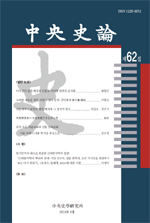본 논문은 고려말 ‘聽政’ 논의의 의미를 추적한다. 禑王代 이후 관인들은 국왕에게 지속적으로 ‘청정’의 시행을 청원하였다. 이 시기의 ‘청정’은 정무의 처결이라는 범칭이기보다 특정한 형태의 정치적 의사 결정 과정을 의미하기 시작하였다. 그 특정한 형태의 ‘청정’은 국왕이 관인들의 朝會를 받은 뒤, 그들로부터 사무를 보고받고 그에 관한 처결을 내리는 것이었다. 그렇다면 관인들이 말하는 특정한 형태의 ‘청정’의 아이디어는 어디에서 온 것이었는가? 그 아이디어의 실천은 어떻게 시작되었는가? 그럼에도 관인들이 지속적으로 ‘청정’의 시행을 청원한 이유는 무엇인가? 본고는 이러한 물음에 대한 대답을 찾아보려 한 것이다. ‘청정’의 아이디어는 어디에서 왔으며 어떻게 시행되었을까? 필자는 공민왕 19년에 명 태조가 보낸 璽書에 주목하였다. 이 새서에서 황제는 청정지소가 있어야 신하들에게 존엄함을 보일 수 있다고 주장하였다. 이후 공민왕은 六府와 臺省의 관인들이 자신에게 직접 啓事하도록 지시하였고, 몇 달 뒤 報平廳에서 첫 ‘청정’을 시행하였다. 「無逸篇」 병풍을 세우는 등 ‘청정’을 준비하는 일련의 과정은 공민왕이 ‘청정’을 통해 자신의 존엄함을 보이는 것에 더 관심이 있었음을 보여준다. 그런데 공민왕은 당초의 계획과 달리 청정의 시행 횟수를 크게 줄였고, 그마저도 잘 시행하지 않은 듯하다. 후대의 국왕들 또한 ‘청정’을 시행하였지만 간헐적이고 일회적이었다. 국왕들이 굳이 ‘청정’을 시행하지 않은 이유의 하나는 소수의 측근들을 통해 대부분의 정무를 처결할 수 있었기 때문일 것이다. 충렬왕의 비칙치나 공민왕의 내재추는 원 복속기 이래 측근정치를 보여주는 상징적인 제도였다. 이와 같은 상황에서 관인들은 소수의 측근들이 정권을 장악하는 것에 비판적이었고, 국왕과 관인 일반의 접점 확대를 통하여 당시의 정치적 모델을 바꾸고자 하였다. 이때 관인들은 몇 차례의 시행 경험이 있는 ‘청정’을 동원하였고, 지속적으로 그 시행을 청원하였다. 관인들은 자신들이 직접 국왕에게 사무를 보고하고 그에 대한 처결을 받음으로써 양자의 접점을 확대할 수 있는 ‘청정’ 모델을 선택한 것이다. 공민왕이 ‘청정’에서 자신의 권위를 강조할 수 있는 부분에만 관심을 가졌던 것과는 관심의 방향이 달랐다.
This paper traces the meaning of “handling matters of state(聽政)” discussions in Goryeo(高麗). From the reign of King Wu(禑王) onwards, the officials(官人) continuously petitioned the king for the implementation of 'handling matters of state'. Rather than being a generic term for the resolution of political affairs, the term came to refer to a specific form of political decision-making process: the king would receive a council of officials, report on their affairs, and make decisions regarding them. Where, then, did the officials' idea of a specific form of “handling matters of state” come from? How did the practice of this idea begin? Why did officials continue to petition for the implementation of handling matters of state? This paper attempts to answer these questions. First, where did the idea of “handling matters of state” come from and how was it implemented? I turned my attention to the Ming Emperor Taizu(太祖)'s letter sealed with an imperial seal(璽書), received in the 19th year of King Gongmin(恭愍王). In this letter, the emperor insisted that the King should have a fixed place to show dignity to his subjects. A few months later, the first “handling matters of state” was carried out at Bopyeongcheong(報平廳). The process of preparing for the “handling matters of state”, including the erection of the “no-frills” folding screen, is interpreted as a demonstration of the king's dignity. However, King Gongmin reduced the number of “handling matters of state” from the original plan, and even then, they seem to have been seldom executed. Subsequent kings also practiced “handling matters of state”, but only intermittently and sporadically. The reason why kings did not enforce “handling matters of state” is because, since the Yuan(元) Dynasty, they were able to handle most of their affairs through a small circle of entourage. King Chungryul(忠烈王)’s bītīkchī(必闍赤) and King Gongmin's inner cabinet(內宰樞) were symbolic institutions that represented aspects of such entourage politics. Under these circumstances, the officials were critical of the dominance of a small circle of officials and sought to change the political decision-making model of the time by expanding the contact between the king and the officials. They mobilized the “handling matters of state”, which they had done several times before, and petitioned for its implementation. The officials chose the “handling matters of state” model because it allowed them to report directly to the king and receive decisions from him, creating more contact between the king and officials.
Ⅰ. 서론
Ⅱ. 明 太祖의 璽書
Ⅲ. 보평청 청정의 시작
Ⅳ. ‘청정’이 필요하지 않은 이유
Ⅴ. 관인들이 생각한 ‘청정’의 성격
Ⅵ. 결론을 대신하여: ‘청정’ 모델이 받아들여질 수 있었던 환경
